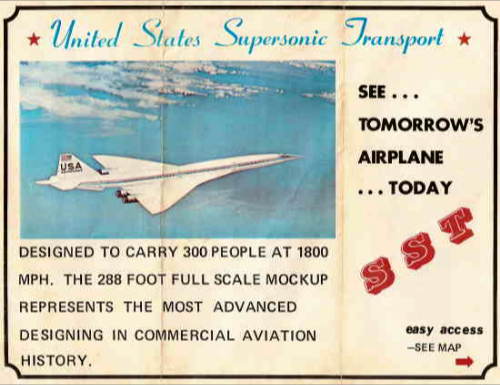
 |
SST Museum
|
|
Home Attractions List Books Poster Gallery Timeline
|

In the 1960's, amid the giddy technological euphoria of the race to the moon and with supersonic military aircraft a proven technology, aircraft designers began to make plans for civilian passenger airplanes that could fly faster than the speed of sound, turning lengthy transcontinental flights into short commuter hops. The British and French were working on their Concorde, the Soviet Union on the Tu-144, and, in the United States, Congress was funding research on building a Supersonic Transport, or SST. The Tu-144 flew first, followed quickly by Concorde, and both eventually entered into service. The American project stalled, however, getting only as far as a full size mock-up before Congress killed the project in 1971, citing concerns over potential damage to the ozone layer and sonic booms. There were also concerns over the plane's commercial viability in the Jumbo Jet era, with high capacity aircraft like the 747 lowering costs per passenger way below what the necessarily smaller SST could sustain with its low capacity and higher fuel costs (interestingly, however, the American design had lagged that of the others due to problems associated with its more ambitious, higher capacity).
The Tu-144 and its variants continued in service on an irregular basis, often flying freight within Russia, until the 1980's; Concorde remained in service until 2003. Today, although several companies claim to be working on next generation supersonic airliner designs, there are no such craft currently in operation. The US program left one artifact, however -- Boeing's full size mockup. It was disassembled and shipped from Seattle to Florida, where it was displayed at the SST Aviation Exhibit Center literally built around it in 1973, off US 192 at the Florida Turnpike, near the Kissimmee airport. The mostly wooden model was unfinished inside, and was so large it was displayed with only one full wing attached and with the tail sticking up through the roof of the metal, warehouse-like display building. In addition to the SST the center featured a display of model aircraft, a large mural depicting the evolution of flight, various prototype or historic aircraft including the Navy's Sea Dart supersonic jet flying boat prototype, and various other aviation related exhibits. The museum closed in 1981. In 1983 the building, complete with SST, was purchased by the Faith World church. For years the Osceola New Life Assembly of God held services there with the airplane still standing above. In 1990 the mock-up was sold to aircraft restorer Charles Bell, who moved it, in pieces, to Merritt Island, in order to preserve it while it waited for a new home as the church now wanted the space for expansion. Eventually it was sold to the Hiller Aviation Museum of San Carlos, California, where it is once again on display. |
|
Return To Florida's Lost Tourist Attractions Brochure image from the author's collection.
The attraction profiled on this page has closed. It no longer exists. That's what this site is all about. This site Copyright (c) 1997-2011 by Robert H. Brown
|